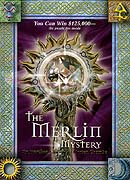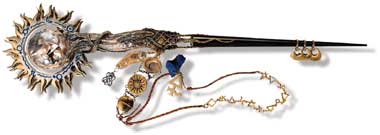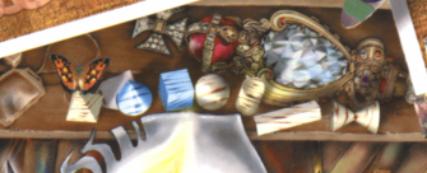The Merlin Mystery
 The Merlin Mystery was published by Voyager (HarperCollins) in 1998, written by Jonathan Gunson and illustrated by Marten Coombe. The book was translated into 7 languages, and tells of the love story between the Wizard Merlin and Nimue the water sprite, and their battle with the Dark Wizards for control of the Alchemist's wand.
The Merlin Mystery was published by Voyager (HarperCollins) in 1998, written by Jonathan Gunson and illustrated by Marten Coombe. The book was translated into 7 languages, and tells of the love story between the Wizard Merlin and Nimue the water sprite, and their battle with the Dark Wizards for control of the Alchemist's wand.
The book is made up of 22 double page spreads. Each one has a border of 48 squares. Sometimes there is a picture inside the border, sometimes there is text telling the story. Littering every page are thousands of small images of objects such as playing cards, runes, statues, plants, zodiac signs, coins, witch hats, clocks, town criers, moons and stars. To look at, the book is extremely chaotic. Although the competition has now closed, the book is still available from booksellers and has a list price of £12.99 ISBN 0002246759
 The prize was a cash fund which grew as more copies of the book were sold, and the alchemist's wand — a jewelled creation designed to add some magic to the contest in the same way as Kit William’s jewelled hare. The final cash prize was £75,000.
The prize was a cash fund which grew as more copies of the book were sold, and the alchemist's wand — a jewelled creation designed to add some magic to the contest in the same way as Kit William’s jewelled hare. The final cash prize was £75,000.
To claim the prize, contestants had to correctly identify ‘the alchemist’s spell’ and ‘the method of casting’, and send these in by post. Little more information was given, which sparked debates on various bulletin boards as to what form this spell and method would take.
Nobody managed to solve the puzzle by the deadline of 31 December 2001. The cash will be donated to the British World Wide Fund for Nature, and the wand will be auctioned. Details of the auction will be posted at the www.merlinmystery.com web site.
A group of puzzlers at www.schatzsuche.com put in a super-human effort, and solved pretty much all of it. Although they had solved each of the solids, they could not see how to put it all together, and did not get as far as drawing the 3D lines and finding the 75 objects.
The full, official solution originally posted at www.merlinmystery.com extends to 10 A4 pages, but in summary, entrants had to locate 75 different objects from the borders of the book’s pages, and put them into the correct order. Some of the objects were actually blanks, to help split up different sections of the solution. The objects were pictures, such that the book could work in any language and be solved by anyone from any country.
The original website is no longer available, but all 75 objects can be found in this offline copy of the official solution.
As an example of how the puzzle was structured, here are the first 16 objects, and their meaning:
You were to interpret this list as follows:
On a night with a full moon, face north and make a salt circle around a 5 pointed star made out of pieces of oak, ash, rowan, hawthorn and elm.
The rest of the 75 objects worked in a similar picture–puzzle way. For example, a gold candle followed by a candle snuffer meant ‘extinguish gold candle’.
 There were 7 puzzles that had to be solved. These puzzles were structured around the seven solids sitting on a shelf on the second double page spread. The solids were a pyramid, a cone, a cube, a sphere, a cylinder, a cuboid and a diabolo.
There were 7 puzzles that had to be solved. These puzzles were structured around the seven solids sitting on a shelf on the second double page spread. The solids were a pyramid, a cone, a cube, a sphere, a cylinder, a cuboid and a diabolo.
Scattered throughout the book, one could find these solids linked by a gold ring to some other object. Elsewhere in the book, that other object was linked by a gold ring to a final object. This final object gave you a hint as to which of the thousands of images in the book were required to solve that particular puzzle.
 For example, the cone could be found linked to a
For example, the cone could be found linked to a  golden eagle, the golden eagle could be found linked to a spitfire, and this told you that the cone puzzle revolved around the spitfires.
golden eagle, the golden eagle could be found linked to a spitfire, and this told you that the cone puzzle revolved around the spitfires.
In summary:
Rather like the master secret in Masquerade that involving drawing lines to pick out words, in the Merlin Mystery the secret is to draw lines to pick out objects. Though the twist here was that the lines had to be drawn ‘in 3D’ through the book.
Return to the site contents or the list of hunts for the general public.